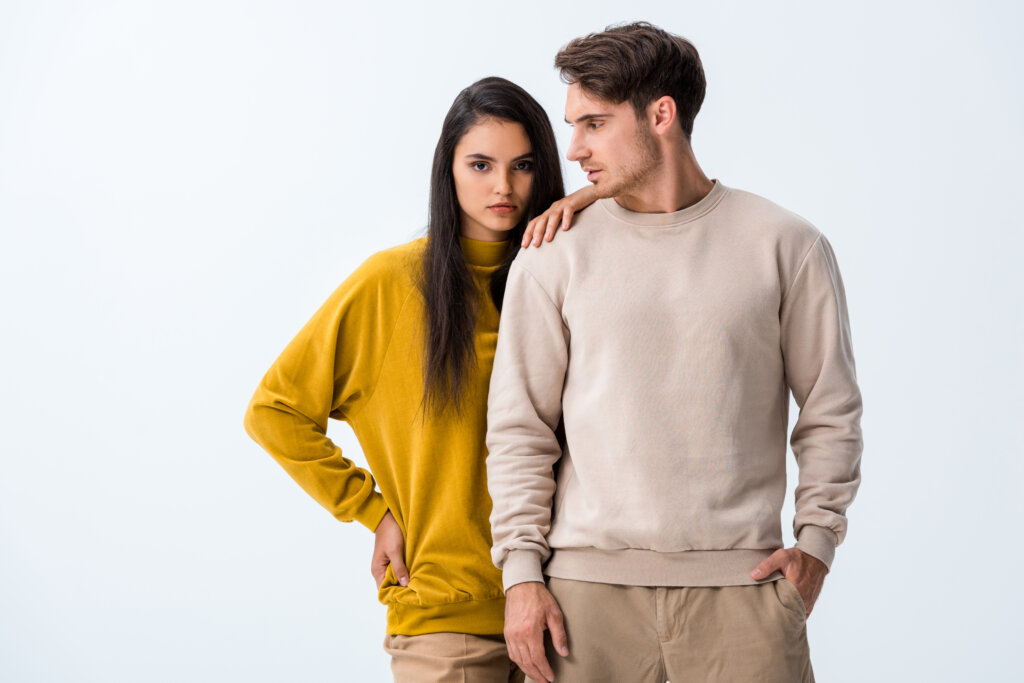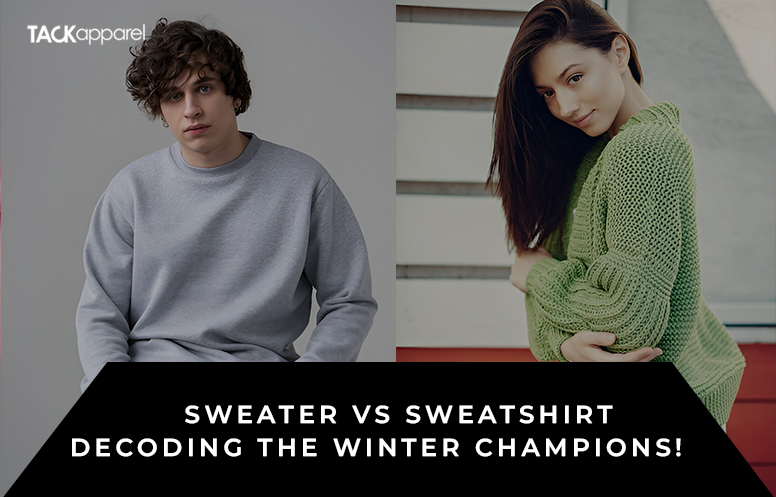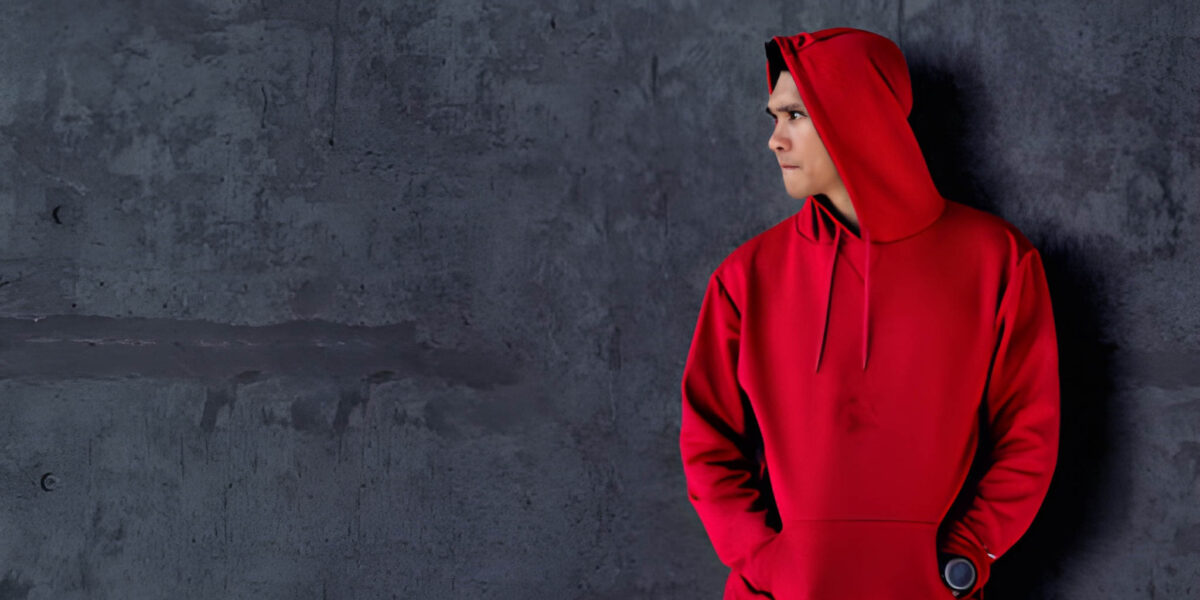Have you ever stared at a rack of comfortable clothes, confused about whether to grab a sweater or a sweatshirt? We have all been there. Both are wardrobe essentials for cold days, but these snug friends have some major differences. This quick guide will break down the world of sweaters vs sweatshirts, helping you choose the perfect piece for your next comfy collection! So, let’s dive in!
Overview of Sweaters and Sweatshirts
Though often used interchangeably, these two types of clothing offer distinct characteristics that cater to different needs and occasions. Understanding the sweater sweatshirt difference can help retailers make informed decisions about which items to stock for their customers, and customers to choose the best according to their style.
Sweater Definition
A sweater is a woven article of clothing meant to provide warmth, usually crafted from fabrics like wool, cotton, or synthetic threads. Different styles of sweaters, such as pullovers, cardigans, and turtlenecks, provide various looks and levels of warmth.
Knitting enables the creation of complex designs and textures, making sweaters suitable for various occasions from casual to formal settings. Sweaters are essential in winter fashion, whether worn alone for comfort or layered over a shirt for a more put-together appearance.
Sweatshirt Definition
Then what’s a sweatshirt? It is a cozy garment typically crafted from cotton or polyester blends, commonly with a fleece lining for extra comfort. Contrary to sweaters, sweatshirts are usually stitched instead of knitted, leading to a sleek outer surface and a soft, warm inner layer. Sweatshirts are mainly linked to informal clothing and sports events, due to their beginnings in athletic attire.
Usual styles consist of crewnecks and hoodies, both offering a comfortable fit ideal for relaxing or casual workouts. Sweatshirts are a convenient and favored option for daily attire due to their low maintenance requirements, with many being suitable for machine washing.
Key Differences Between Sweaters and Sweatshirts

The debate of “What is the difference between a sweater and a sweatshirt?” is an ongoing one. This section will break down the unique characteristics of each garment, focusing on its materials, design and construction, functionality, use cases, and care instructions.
Material
Sweatshirts
Sweatshirts are typically made from a mixture of cotton or polyester. These sweatshirt materials frequently include a layer of fleece inside, providing additional warmth and comfort. Sweatshirts are a popular option for both casual and athletic wear because cotton offers comfort and breathability, and polyester provides durability and moisture-wicking qualities.
Sweaters
Sweaters are usually crafted from premium sweater materials such as wool, cotton, or synthetic fibers. Wool is renowned for its exceptional insulating capabilities, ideal for staying warm in chilly environments. Cotton sweaters provide comfort and breathability, despite offering less insulation. Acrylic is commonly used to produce low-cost, low-maintenance alternatives that imitate the look and texture of natural fibers.
Design and Construction
Sweatshirts
Sweatshirts are typically created using stitched material, with a sleek outer surface and a cozy inner layer. This building technique is easier than knitting and produces a stronger, more consistent material. The sleek outer surface is ideal for printing designs and adding decorations, while the plush, fleece-lined inside offers coziness and warmth.
Sweaters
Sweaters are typically made through knitting or crocheting, leading to a range of patterns and textures in their design and construction. This method enables complex patterns, such as cables, ribbing, and fair isle designs. The knitting technique also provides sweaters with their distinctive ability to stretch and bend, creating comfort and versatility for various body types.
Functionality and Use Cases
Sweatshirts
Sweatshirts are created for both relaxed and active dressing. They are commonly linked with sports, physical activity, and relaxation pursuits because of their comfort and usability. Hoodies are also a key component of streetwear style, recognized for their loose fit and fashionable patterns. They go well with jeans, joggers, and sneakers, becoming a top pick for everyday casual outfits.
Sweaters
Sweaters in comparison to a sweatshirt are perfect for dressing up or dressing down, making them a flexible and practical addition to any closet. They are perfect for wearing over shirts or under jackets, offering both warmth and style. Sweaters are also ideal for formal events like business meetings, dinners, and other social gatherings when a refined appearance is needed.
Care Instructions
Sweatshirts
Sweatshirts compared to sweaters can generally be washed in a machine, which makes them simpler to maintain. The cotton and polyester blends in sweatshirts are so durable that they can withstand frequent washing without much damage. To keep the fleece lining soft, it is advisable to launder sweatshirts in cold water and tumble dry on low heat.
Sweaters
Sweaters against sweatshirts frequently need to be washed gently to preserve their shape and quality. Wool sweaters, in particular, might require hand-washing or dry-cleaning to prevent shrinkage and pilling. Cotton and synthetic sweaters may be suitable for machine-washing on a delicate cycle, but it is recommended to adhere to the care label guidelines for prolonged durability.
Types of Sweaters

Explore the types of sweaters, from pullovers to trendy cardigans, and find the perfect fit for your product lines.
- Pullover Sweater: This classic sweater design is pulled over the head and worn without any front openings. It comes in a variety of materials, styles, and neckline options, providing flexibility for a range of occasions.
- Cardigan: A sweater that has a front closure with either buttons or a zipper. Cardigans are versatile clothing items that can be worn either opened or closed, providing both style and warmth to an ensemble. Sweatshirts cannot come in front open form, unlike sweaters in the sweatshirt versus sweater debate.
- Turtleneck: A sweater with a large collar that almost covers the neck. Turtlenecks are often preferred for their shiny and intricate appearance, as well as for their ability to keep you warm.
- Crewneck: There is also a distinction in the crewneck style between a sweater and a sweatshirt. Crewneck sweaters are a timeless essential in any wardrobe, offering a versatile and laid-back style that complements a variety of bottoms.
- V-Neck: A V-neck sweater creates the illusion of a longer torso and brings a sense of sophistication to any attire. V-neck sweaters can be styled in multiple ways, either for a casual or formal occasion.
Types of Sweatshirts

Find out the versatile types of sweatshirts, from classic crewnecks to trendy hoodies, and find the perfect fit for every occasion.
- Crewneck Sweatshirt: A classic style sweatshirt with a rounded neckline that gently hugs the neck. Crewneck sweatshirts are comfortable and relaxed, commonly worn for hanging out or engaging in physical activities.
- Hoodie: A hoodie provides additional warmth and coverage with its attached hood at the back. Hoodies are well-known as casual attire and typically include a front pouch for extra convenience.
- Zip-Up Sweatshirt: A zip-up sweatshirt designed for easy wearing and removal, with a front opening for convenience. Zip-up hoodies provide flexibility in how they are styled and can be worn slightly unzipped for a more relaxed appearance.
- Graphic Sweatshirt: A hoodie adorned with found or stitched images, symbols, or phrases. Sweatshirts with graphics bring a touch of personality to an ensemble and are trendy with the younger crowd. Sweaters cannot feature graphic designs, unlike sweatshirts in the sweatshirt vs sweater debate.
- Pullover Hoodie: This is like a traditional hoodie but lacking a zipper. It provides a front pocket and a hood for both comfort and fashion.
Market Demand and Trends
When it comes to retailers, they must understand the market demand and trends to make informed decisions about their product lines of sweaters and sweatshirts. The fashion industry is constantly evolving, influenced by the changing seasons, consumer preferences, and emerging fashion trends. To meet customer demands and maximize sales, retailers must keep up with these trends.
Current Market Trends
Current market trends show an increasing demand for versatile, eco-friendly, and fashionable sweaters and sweatshirts. Data indicates that as consumers become more conscious of the environment, they are rating eco-friendly materials like organic cotton and recycled fibers as the best fabric for sweaters and the best fabric for sweatshirts.
Baggy and loose styles are taking over the industry, offering comfort without sacrificing fashion. Furthermore, there is a noticeable increase in the need for athleisure clothing, which blurs the distinction between casual and activewear, leading to sweatshirts becoming a trendy option.
Advancements in fabric technology such as moisture-wicking and temperature-regulating properties are becoming more popular, attracting a health-conscious and active demographic. Retailers can take advantage of these trends by providing a variety of sweaters and sweatshirts that address these changing consumer demands.
Consumer Preferences
Currently, retail consumers prefer sweaters and sweatshirt design ideas that combine style, comfort, and functionality. They are looking for clothes that not only appear stylish but also offer warmth and are easy to maintain. In terms of style, there is a strong demand for minimalist designs with understated patterns and neutral colors, as they provide flexibility and can be effortlessly incorporated into different ensembles.
Comfort is still a key focus, with a preference for soft, breathable materials to provide a comfortable wearing experience. Consumers are seeking pieces that can effortlessly transition from casual daywear to formal evening looks, making functionality vital.
Elements like pockets, hoods, and machine-washable fabrics enhance the attraction, making these clothing items suitable for daily use. Retailers can improve their product offerings by recognizing and meeting consumer preferences.
Sweater or Sweatshirt: Which One is Best for You?

Well, now here’s a deal. Personally, I love wearing clothes that offer me comfort, therefore this question is highly preference dependant. But, I can surely provide some friendly bits of advice. If you reside and travel to cooler regions, and attend formal or semi-formal events, a sweater is the best choice for you. A sweater is also a good option for you if you prefer style and elegance over comfort. You can easily pair your sweater with shirts and blouses to layer on.
However, if you live in a slightly less cooler region and looking for something to wear for casual dayouts or athletic activities, then definitely go for sweatshirts. If you’re fond of snug and comfort and find yourself fine with informal fashion, sweatshirts are ideal for you. You can easily pair your sweatshirts with denim and joggers and you’re good to go.
The Final Stitch For Choosing the Right Option for Your Customers!
So, in sweater and sweatshirt comparison, we can say that sweaters and sweatshirts have unique qualities that make them appropriate for various purposes and events. Sweaters, commonly crafted from wool, cotton, or synthetic materials, provide both comfort and fashion for casual and formal occasions. Sweatshirts made of cotton or polyester blends with fleece linings offer comfort and longevity for both casual and athletic use. Retailers must comprehend these variances to make well-informed inventory choices that align with consumer needs. To find top-notch sweaters and sweatshirts, contact Tack Apparel to discover our customization choices that can meet your retail requirements.




